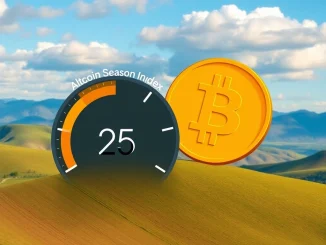
Are stablecoins just a crypto thing? Think again. A recent Citi report highlights how Stablecoin growth is increasingly influencing traditional financial markets, specifically by driving Treasury bill demand.
How is Stablecoin Growth Impacting Traditional Finance?
According to analysis from Citigroup, stablecoins, which are digital currencies pegged to stable assets like the U.S. dollar, are becoming major players. Their expanding use isn’t just confined to crypto trading; it’s spilling over into the world of traditional finance. A key area of impact? Short-term U.S. Treasuries.
Here’s the core idea:
- Stablecoin issuers often hold reserves to back the value of their stablecoins.
- These reserves frequently include highly liquid, low-risk assets.
- Short-term U.S. Treasury bills are a prime example of such assets.
As more people use stablecoins for various purposes – from trading to payments – the demand for these underlying reserve assets, like Treasuries, goes up. This creates a direct link between the expanding stablecoin market and traditional government debt markets.
Could Regulation Accelerate This Trend?
The Citi report suggests this trend could pick up speed. Why? Potential U.S. legislation aimed at regulating stablecoins might mandate that issuers hold specific types of reserves, often favoring assets like short-term Treasuries. Stricter reserve requirements could solidify and even increase the connection between stablecoin issuance and Treasury bill demand.
What Does the Future Hold for the Stablecoin Market?
Citigroup offers a significant projection for the stablecoin market, estimating it could swell to a size between $1.6 trillion and $3.7 trillion by 2030. This indicates substantial potential growth from current levels.
However, this growth isn’t without potential speed bumps. The report cautions that regulatory constraints, including possible limitations on how issuers can earn yield from their reserve assets, could temper this expansion. Understanding the nuances of future crypto regulation is key to forecasting the market’s trajectory.
Why Does This Matter Beyond Crypto?
The patterns observed in stablecoin issuance offer more than just insight into the crypto world. The Citi report notes they provide a window into broader shifts happening within the global monetary system. The increasing integration of digital assets, particularly stablecoins, into financial infrastructure could signal significant changes in how value is stored, transferred, and managed globally.
For investors, policymakers, and anyone watching the evolution of finance, the relationship between Stablecoin growth and Treasury bill demand is a critical area to monitor. It underscores the growing interconnectedness of crypto and traditional finance, driven in part by the mechanics of the stablecoin market itself and the evolving landscape of crypto regulation.
In Conclusion
The findings from Citigroup underscore the growing influence of stablecoins well beyond the confines of cryptocurrency trading. Their expansion is creating tangible effects on traditional markets, particularly boosting demand for U.S. Treasury bills. While regulatory developments and other factors will shape the ultimate size of the stablecoin market, its current trajectory highlights an important convergence between digital assets and traditional finance, signaling potential shifts in the global financial architecture.



